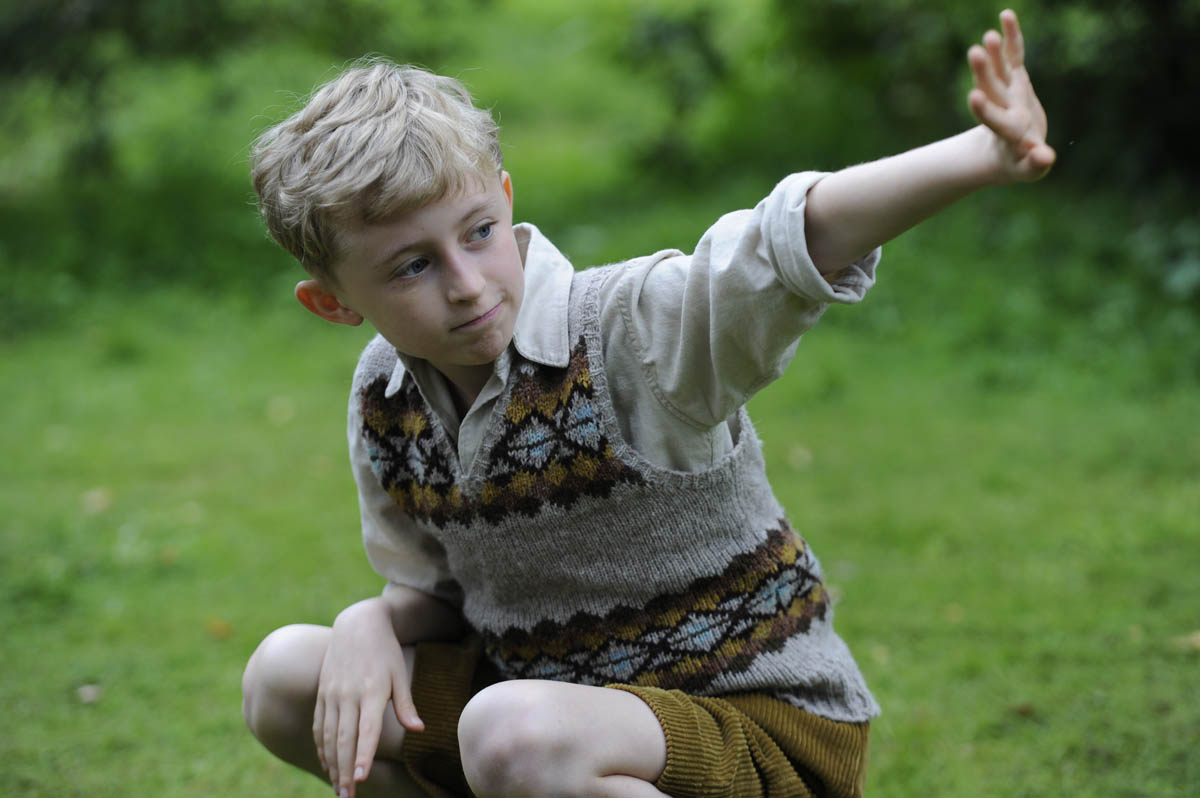In Tell It to the Bees, sex is aberrant unless it’s conducted by a straight married couple. Since Annabel Jankel’s low-key drama is set in a grim Scottish mill town in 1952, you can add “white” to that dictum. We’re in the land of John Knox here and the suffocating mood of repression is summed up in the taut face of the factory forewoman Pam (the great Kate Dickie), who tells the machinist Lydia (Holliday Grainger), her Mancunian sister-in-law, “What was my brother thinking of, bringing home a wild one like you?”
Based on the semi-autobiographical third novel by Fiona Shaw, Tell It to the Bees is a solid movie – at least until it mobilises a swarm of the eponymous insects as a deus ex machina. However, the screenplay by Henrietta Ashworth and Jessica Ashworth doesn’t offer a clear enough sense of who the protagonist is. Is it Lydia, whose abandonment by her surly husband Robert (Emun Elliott) has left her weepy and craving intimacy? Or is it her son Charlie (Gregor Selkirk, pictured below), a schoolboy who serves as witness to Lydia’s evolving love life and is affected by her choices? They are both sympathetic characters, but the viewer needed anchoring in one or other of them.
As an observer of “illicit” adult behaviour, Charlie has much in common with the Victorian lad in The Go-Between (filmed twice) and the son of Carey Mulligan’s character in Wildlife. It’s often disturbing for pre-adolescents to discover their parents having sex. Discovering one of them having sex with a person who isn’t the other parent can be devastating. In Dennis Potter’s The Singing Detective, the young Philip Marlow is given a horrendous Oedipal blow by witnessing his mother being done in the Forest of Dean by a more virile man than his father: as an adult entrapped in a psychosomatic disease, Marlow re-enacts the incident in a series of masochistic fantasies. In contrast, Charlie isn’t psychologically damaged, apparently, by seeing Lydia having sex with her lover. He is shocked at the time and flees to live with Robert, who has moved in nearby with Pam and her daughter Annie (Lauren Lyle). Charlie soon wants to return to Lydia. His reaction is muted because he didn’t find her in bed with a rampaging Alpha male but the gentle woman doctor Jean Markham (Anna Paquin in fine form). Once banished from the town by her father for being a lesbian, Jean has returned, following his death, to take up his practice.
In contrast, Charlie isn’t psychologically damaged, apparently, by seeing Lydia having sex with her lover. He is shocked at the time and flees to live with Robert, who has moved in nearby with Pam and her daughter Annie (Lauren Lyle). Charlie soon wants to return to Lydia. His reaction is muted because he didn’t find her in bed with a rampaging Alpha male but the gentle woman doctor Jean Markham (Anna Paquin in fine form). Once banished from the town by her father for being a lesbian, Jean has returned, following his death, to take up his practice.
Jean met Charlie when he came to her as a patient, bonded with him by showing him her beehives, and offered him and Lydia rooms in her spacious house when, unsupported by Robert, they were evicted from their home. Seven years after the war, ex-soldier Robert hasn’t readjusted to civvy street. The film (if not Lydia initially) resists his gruff, overbearing machismo and his threatening moustache. (He’s a milder version of the abusive husband, a Scottish World War I casualty, in Terence Davies’ Sunset Song.)
Charlie’s voiceover narration, which is spoken (by Billy Boyd) at the beginning and end of the film as a man looking back on these events, reflects that Lydia and Jean’s love had, in fact, eased his own journey into adulthood. As much was hinted when he denied Robert’s wish to bring him up in order to make a real man of him because, he says, he can’t be one. The film’s addressing of intolerance extends beyond same-sex romance. Annie is overjoyed when her boyfriend makes her pregnant, but Pam intervenes because he is West Indian. The outcome is bloody.
Skilfully played by Grainger, Lydia is educated (she associates telling secrets to bees to “The Bee-Boy’s Song” from Kipling’s Puck of Pook’s Hill) and intelligent, but also reactive and lacking in self-awareness. When Pam call her “wild", she presumably means “over-sexed". There’s a baffling scene in which Charlie spies on her, the lone woman in a pub, getting drunk and dancing with a predatory man after she’s been fired from her job. She doesn’t notice Jean’s attraction to her when they first take tea. Paquin’s eyes – those of a discreet woman falling in love at first sight – register Jean’s fear and uncertainty, but also the possibility that Lydia may reciprocate her feelings. Jean’s bees eventually bring them together.
Lovingly tended by Charlie (and lovingly photographed in close-up by cinematographer Bartosz Nalazek), the bees have a metaphoric role to play – nature, which has its own logic, is fierce and won’t be trammelled by man-made rules (not in 1952 anyway). Jankel, co-creator of the 1980s AI TV host Max Headroom and director of the 2009 TV movie Skellig: The Owl Man, handles the bees well until they embark on their US Cavalry mission.














Add comment